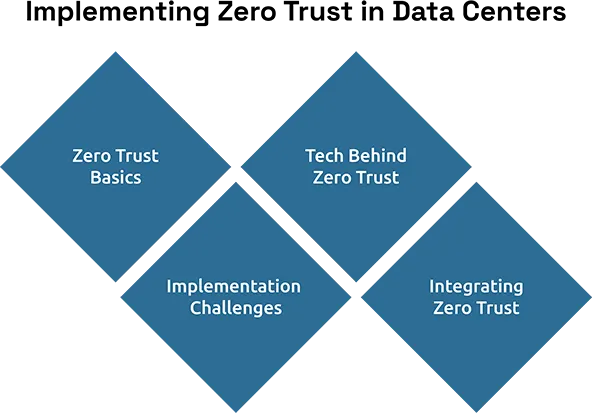The traditional security method of “trust but verify” is no longer enough in today’s challenging digital world. As cybersecurity threats become more upgraded, organizations are moving towards a Zero Trust Security Model to protect their cloud computing data centers. Differing from previous security models that focus on protecting the perimeter of the network, Zero Trust accepts that threats can come from both inside & outside the network. This means that strict identity verification is needed every time someone tries to access the system.
With the increasing growth of data centers and cloud computing, accepting Zero Trust is important for keeping sensitive data safe & confirming that operations remain strong & reliable.
Understanding the Zero Trust Security Model
The Zero Trust security model is based on three main principles that help organizations protect their data and systems. The first principle is “Verify Explicitly.” This means that every access request must be authenticated, no matter from where it comes. Whether a user is inside or outside the network, they must prove their identity before being granted access.
The second principle is “Least Privilege Access.” This method makes sure that users & devices are given only the minimum permissions they need to perform their operations. By limiting access, organizations can minimize the risk of unauthorized actions & protect sensitive information.
The third principle is “Assume Breach.” This means that organizations should always be on the lookout for possible threats. Continuous monitoring is important to identify any suspicious activity instantly & provide fast responses to security threats
These principles are especially useful for data center virtualization in cloud computing, where workloads are spread across various environments. By applying the Zero Trust model, organizations can improve their security & data protection, no matter their location.

The Need for Zero Trust in Modern Data Centers
The growth of virtual data centers in cloud computing has delivered new security challenges. Not like traditional data centers, which have clear physical boundaries, cloud environments use virtual machines & software-defined networks. This makes depending on edge security measures are lacking. That’s why accepting a zero-trust method is important.
Zero Trust helps to minimize insider threats. By providing access only on a need-to-know basis, organizations can limit the chances of unauthorized access from within. This means that even if someone has access to the network, they can only see & use the information required for their role.
Many industries have strict rules about data access & security, & Zero Trust helps organizations address these requirements by imposing strict access limitations controls. This confirms that only the right people have access to sensitive information.
Zero Trust is successful in protecting hybrid environments, which include both public cloud data centers & on-premise networks. It allows for smooth integration across different types of environments, making sure that security measures are constant & successful, no matter where the data is stored. In general, Zero Trust is important for addressing the unique security needs of modern data centers.
Implementing Zero Trust in Data Centers
To effectively adopt Zero Trust in the virtualization of cloud data centers, organizations need to follow several important steps. they should focus on Identity & Access Management. IAM services help to confirm that only authorized users & devices can access Important systems. The main features of IAM include multi-factor authentication, which adds an extra layer of security, & flexible access controls that adjust permissions based on user behavior & context.
One more important step is micro-segmentation. This includes breaking the network into smaller, controlled sections, which helps to prevent threats from moving freely within the data center. By dividing the network into isolated parts, organizations can better containAny possible security risks.
Continuous monitoring and analytics are also important for a successful Zero Trust implementation. By using AI & machine learning-based threat detection tools like Grok AI, organizations can analyze user behavior & identify unexpected activities in real-time. This proactive method allows for immediate responses to possible risks.
Secure Access Service Edge plays an important role in integrating Zero Trust principles with cloud computing. SASE gives safe access to resources that are spread out over different sites, confirming that users can safely connect to the data they need, no matter where they are. these steps create a Strong security structure for modern data centers.

The Role of Virtualization in Zero Trust Security
Virtualization plays an important role in implementing Zero Trust security in cloud computing. In a virtualized data center, resources are covered through software, which allows for a more flexible & efficient application of security policies. One important feature is policy-based access, which makes sure that only verified users can access. Also, encryption is used to protect data both while it is being transferred & when it is stored. One more benefit of virtualization is automated threat response, where AI-based security systems can Immediately isolate any affected systems to avoid further issues.
Future Trends: Zero Trust and Data Center Evolution
As many businesses use cloud computing, Zero Trust Security is progressing to keep new demands. One important trend is the use of AI for threat detection, where advanced AI systems look at large amounts of network data to find possible threats before they become serious problems. One more trend is Zero Trust Edge Computing, which means that security measures are now being applied to devices at the edge of cloud computing centers, not just the main data center. governments are introducing stricter security rules that data centers must follow.
Conclusion
Zero Trust security is important for protecting cloud-based data centers. As cybersecurity threats become more difficult, organizations need to take a proactive method to keep their data & operations safe. By using tools such as Grok AI, micro-segmentation, & Identity and Access Management, organizations can create a strong security system that addresses the future needs of the data center industry.








